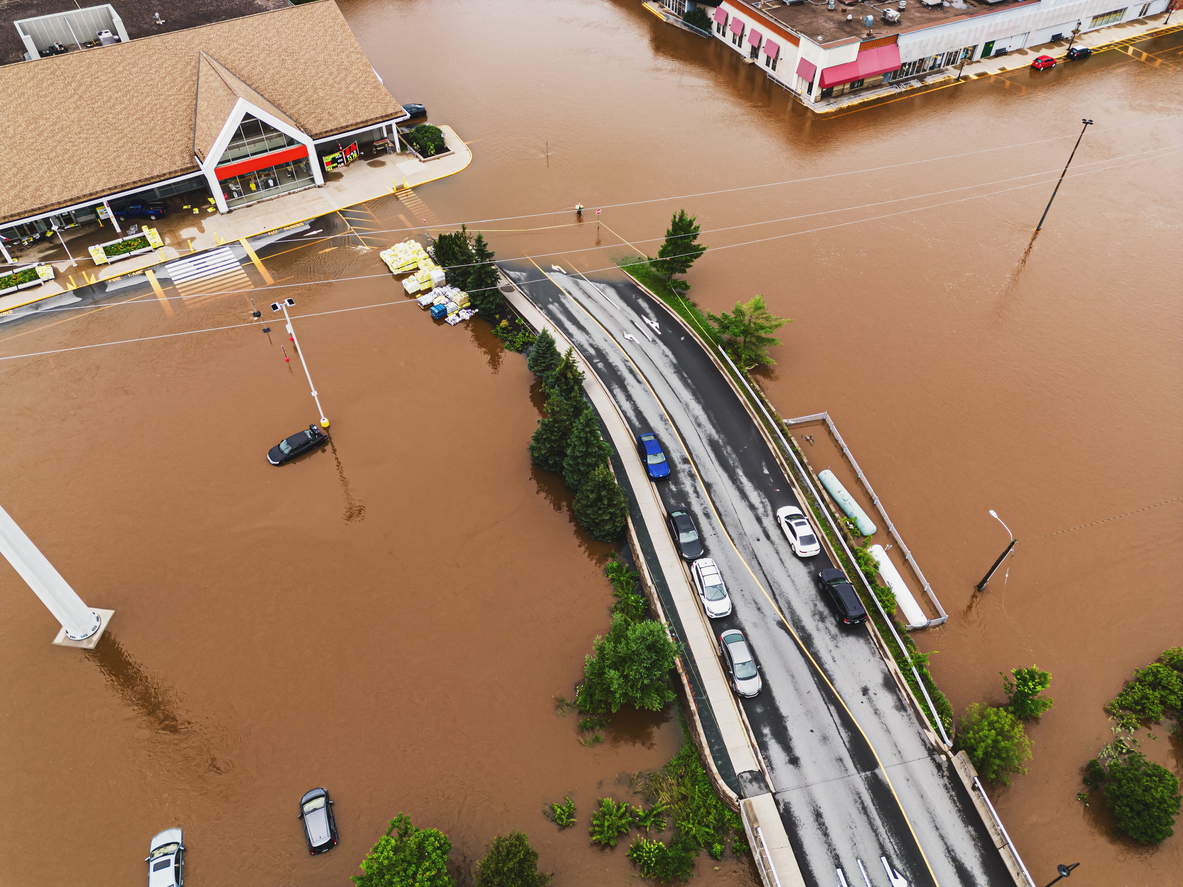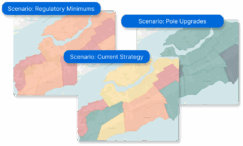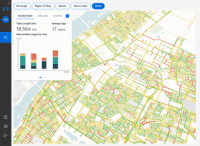How can cities protect themselves against floods?
Published on September 24th, 2024
Floods are the most common and costliest disaster in Canada. Over the past decade alone, floods have averaged almost $800 million in insured losses annually.
According to initial estimates from Catastrophe Indices and Quantification Inc. (CatIQ), the flash floods that occurred across southern Ontario in July 2024 have caused over $940 million in insurance damage. Nearly 10 centimeters of rain fell in just 3 hours, overwhelming stormwater infrastructure and leading to catastrophic damage.
A month later in Quebec, the remnants of Hurricane Debby brought record-breaking floods to the region. Some communities along the St. Lawrence received between 100 and 221 millimeters of rain, prompting municipalities to declare a state of emergency and forcing thousands of residents to evacuate or remain isolated.
These are just two recent examples of floods becoming simultaneously more common and more severe. Given the recent damage, the question arises: “How can cities protect themselves against floods?
Table of Contents
Why are floods becoming more common and more severe?
The concept of a 1-in-100 year flood event is becoming outdated due to climate change.
Global warming from climate change leads to more evaporation and more moisture in the atmosphere. A 1°C rise in temperature can increase water vapor in the air by 7%. With average surface temperatures in 2020 being 1.11°C warmer than a century ago, moisture levels in the air—and clouds—can be nearly 9% higher.
With more water in the atmosphere, heavier and more intense precipitation is more likely, exceeding the capacity of existing stormwater systems.
The risks floods bring
Floods are among the most devastating natural disasters, capable of causing widespread damage and disruption in a matter of hours.
Beyond the immediate threat to life and property, floods bring a cascade of risks that can have long-lasting impacts on communities.
From degrading infrastructure to triggering health crises and economic losses, the ripple effects of flooding typically leave vulnerable areas grappling with challenges that often take years to overcome.
Understanding these risks is essential for developing effective strategies to ensure the sustainable performance of essential infrastructure when it pours.
Property and infrastructure damage
Property damage is perhaps the best known impact of flooding. When water inundates homes and commercial buildings, it typically leads to structural damage to foundations, walls, and flooring. It can also do extensive damage to insulation, electrical systems, and personal belongings. Plus, mold and mildew growth caused by moisture can further compromise a building’s safety.
Meanwhile, there are several ways floods can impact infrastructure long-term.
Floods can weaken and erode road surfaces, washaway roadbeds, and damage bridges. Stormwater systems, particularly older ones, can quickly be overwhelmed by a sudden influx of water, leading to backups, overflows and exacerbate damage to property in urban areas.
Sewage and wastewater system can overflow during heavy rain, discharging raw sewage into streets, homes, and water bodies, creating public health hazards. This is particularly true of older systems across Canada.
Floods can also cause electrical grids to fail. Power outages are common during floods, as transformers and other critical components may be submerged or damage, disrupting service for extended periods of time.
Public health and safety hazards
Floods carry many public health and safety hazards. Namely, floods can be fatal and cause injuries. Drownings, hypothermia, electrocutions, and more are all very real risks any time a flood strikes.
Furthermore, there are psychosocial impacts such as higher levels of stress or PTDS after a flood hits. In 2019, a few months after Quebec was hit with major flooding, the Institut national de santé publique du Québec found that 44% of the people affected had moderate to high symptoms of post-traumatic stress.
And as mentioned above, heavy rainfall can overwhelm drinking water treatment systems, degrading water quality and increasing the risk of waterborne diseases. Over half of the waterborne disease outbreaks in the past 50 years in the United States occurred after extreme rainfall events.
As floods become more frequent and severe, mitigating these public health and safety hazards with climate adaptation investments.
What can cities do to mitigate flood risks?
As the impacts of climate change on flooding are already affecting our communities, local governments must start preparing for the increased risks both now and in the future. At the local level, mitigating flood risks means investing in climate-resilient infrastructure.
Of course, this is much easier said than done.
Local governments have limited resources to invest in replacing old stormwater infrastructure and acquire new climate-resilient assets. To make matters worse, cities already face a significant infrastructure deficit. Meaning that road, bridge, and water infrastructure already need maintenance or are approaching the end of their useful life.
This backlog creates a dual challenge. Not only do municipalities need to address aging infrastructure to meet their service level targets, but they also must adapt to the increasing demands posed by climate change.
As a result, cities often struggle to prioritize their spending and find the ideal balance the need for immediate repairs with the long-term goal of building climate-resilient systems that can withstand future flooding and extreme weather.
Thankfully, there are solutions available to help local governments manage the challenges of limited resources and infrastructure deficits while addressing climate risks like increased flooding.
Prioritizing and optimizing with Asset Investment Planning
Asset Investment Planning (AIP) are solutions support asset-intensive organizations, like local governments, by optimizing their capital investment and project portfolio management through data-driven insights.
These solutions leverage advanced predictive modeling, decision analytics, integrated risk management, probabilistic simulation, and scenario analysis to evaluate the long-term performance of assets and investments.
By assessing potential risks, costs, and benefits of various projects, AIP tools enable organizations to allocate resources more efficiently and ensure that infrastructure investments align with strategic goals, including reducing infrastructure deficits while investing in climate-resilient infrastructure.
An AIP solution can assist cities with:
Prioritizing investments
An AIP solution uses data-driven insights to evaluate and prioritize infrastructure investments.
It helps cities identify which assets—such as aging stormwater systems—are most critical and in need of immediate attention, ensuring that resources are allocated where they can have the most significant impact. By focusing on high-risk or high-priority assets, local governments can maximize the effectiveness of their limited budgets.
Scenario analysis
AIP solutions allow governments to model different scenarios, such as the potential impacts of climate change on flood risks, and evaluate the cost-effectiveness of various investment strategies.
This capability helps decision-makers assess how different approaches, like upgrading stormwater systems or investing in green infrastructure, will perform under various conditions. By understanding the potential outcomes of each investment, cities can make informed decisions that balance current needs with long-term resilience.
Optimizing maintenance and repairs
By providing detailed insights into the condition and expected lifespan of infrastructure assets, an AIP solution helps governments optimize maintenance and repair schedules.
This ensures that essential infrastructure is maintained proactively, reducing the likelihood of costly emergency repairs. It also allows for better planning of replacement or upgrade cycles, reducing the risk of infrastructure failure during extreme weather events.
Long-term planning for resilience
AIP solutions enable cities to take a long-term approach to asset management by integrating climate projections and sustainability goals into their planning.
By evaluating the future risks posed by floods and other climate-related events, cities can develop a clear strategy for building climate-resilient infrastructure over time. This includes considering how assets will perform in changing environmental conditions and planning investments that protect against future risks, not just current challenges.
Municipal Asset Investment Planning
Optimize your city’s future with Direxyon’s turnkey Municipal AIP solution.
Learn more
Investing in climate resiliency with AIP
Climate change is having an increasing impact on the lives of Canadians, with the costs of damage from extreme weather events like floods and wildfires on the rise.
While the effects are widely felt, investing in climate-resilient infrastructure remains a significant challenge for municipalities.
Fortunately, Direxyon’s Asset Investment Planning (AIP) solution empowers municipalities to simulate and compare the most effective ways to invest in climate resilience.
By utilizing AIP, municipalities can navigate complex funding options, balance political and financial pressures, and make data-driven decisions that strengthen their long-term resilience.
To learn more about how Direxyon can help your municipality become more climate resilient, contact us today.
Let us show you how it works
Our product specialists will walk you through our proven approach to enhance your capital investment planning.

Explore resources
-
 News
NewsDIREXYON Launches GO, an AI-Powered Platform to Streamline Strategic Infrastructure Investments
Read more : DIREXYON Launches GO, an AI-Powered Platform to Streamline Strategic Infrastructure InvestmentsSelf-serve Digital Twin delivers clarity to strategic infrastructure decisions Montreal, QC, September 18, 2025 – DIREXYON Technologies today announced the launch of DIREXYON GO, a self-serve platform that simplifies and accelerates Asset Investment Planning (AIP) for municipalities and utilities. DIREXYON…
-
 E-book
E-bookTurning Wildfire Data into Smarter Investments
Read more : Turning Wildfire Data into Smarter InvestmentsYour wildfire data can do more than predict where fires may spread. It can guide the decisions that protect your grid and your communities. Wildfire threats are rising, regulations are tightening, and budgets are stretched thin. Utilities need more than…
-
 Blog
BlogWhat is Strategic Asset Management?
Read more : What is Strategic Asset Management?Strategic Asset Management is more than a buzzword. It’s a transformative shift in how municipalities and electric utilities manage infrastructure, budgets, and long-term risk. At its core, strategic asset management is about using data to make better decisions. Instead of…


